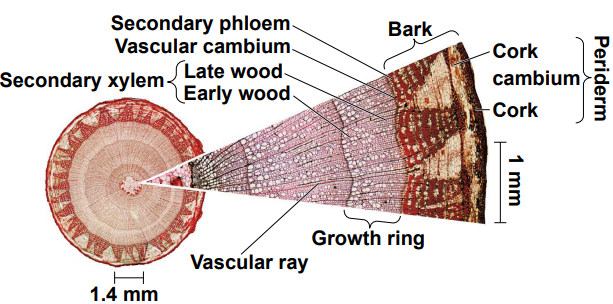C35 | Plant Structure and Growth
Are Plants Computers?
(True) - Plants such as romanesco, grow according to a genetically determined, repetitive program.
Plant Development - It is also dependent on environmental conditions, much more so than animals.
(True) - Growth in response to environmental change facilitates resource acquisition in plants.
Concept 35.1: Plants Have a Hierarchical Organization Consisting of Organs, Tissues, and Cells.
(True) - Plants have organs composed of different tissues, which in turn are composed of different cell types.
Cell - It is the fundamental unit of life.
Tissue - A group of cells consisting of one or more cell types that together perform a specialized function.
Organ - Consists of several types of tissues that together carry out particular functions.
Basic Vascular Plant Organs: Roots, Stems, and Leaves
Morphology - Basic ___ of vascular plants reflects their evolution as organisms that draw nutrients from below ground and above ground.
Water and Minerals - What do plants take up below ground?
CO2 and Light - What do plants take up above ground?
Roots, Stems, Leaves - Three basic organs evolved to facilitate efficient resource acquisition.
Root System & Shoot System - Plant organs are organized into two systems, which are?
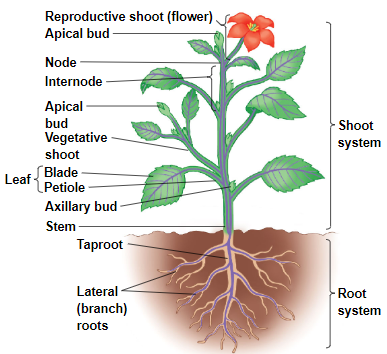 Roots - What relies on sugar produced by photosynthesis in the shoot system?
Roots - What relies on sugar produced by photosynthesis in the shoot system?
Shoots - What relies on water and minerals absorbed by the root system?
Roots
Root - An organ that anchors the plant, absorbs minerals and water, and stores carbohydrates.
Primary Root - What is the first emerging root?
Lateral Roots - The primary root branches to form , which improve anchorage and water absorption.
Taproot System - Tall plants with large shoot masses generally have a _ System.
Taproot - This generally develops from the primary root and functions in anchoring the plant in the soil.
Fibrous Root System - Small or trailing plants generally have this root system that spreads out like a thick mat below the soil surface.
(True) - In the fibrous root system, the primary root dies early on and does not form a taproot.
Adventitious Roots - These roots arise from the stem and give rise to many branching lateral roots.
(True) - In most plants, absorption of water and minerals occurs primarily near the tips of roots.
(True) - Absorption primarily occurs in the tips of the lateral roots.
Root Hairs - Finger-like extensions of epidermal cells, form near the root tip and increase the absorptive surface of the root.
Mycorrhizal Associations - Most root systems form ___ Associates.
(True) - Many plants have root adaptations with specialized functions.
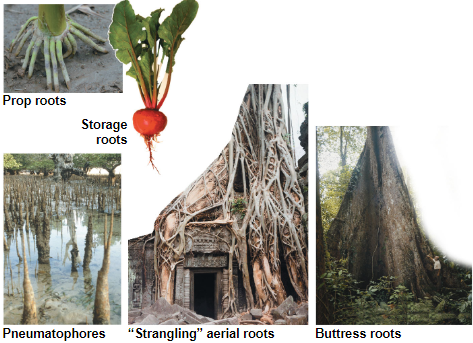 Stems
Stems
Stem - A plant organ consisting of an alternating system of nodes and internodes.
Nodes - Points at which leaves are attached.
Internodes - The stem segments between nodes.
Apical Bud - The growing tip that causes elongation of a young shoot.
Axillary Bud - A structure that has the potential to form a lateral branch, thorn, or flower.
Stem - Its primary function is to elongate and orient the shoot to maximize photosynthesis.
(True) - Many plants have modified stems that perform alternate functions (eg. rhizomes, stolons, tubers).
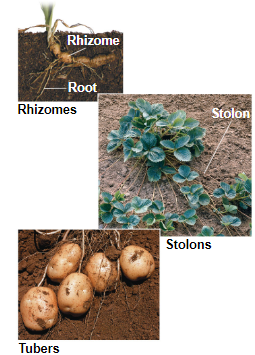 Leaves
Leaves
Leaf - It is the main photosynthetic organ of most vascular plants. They intercept light, exchange gases, dissipate heat, and defend the plant from herbivores and pathogens.
(True) - Leaves generally consist of a flattened blade and a petiole.
Blade & Petiole - What generally comprises leaves?
Petiole - A stalk that joins the leaf to a node of the stem.
(True) - Monocots and eudicots differ in the arrangement of veins.
Veins - It is vascular tissue of leaves.
Monocots - Parallel veins in leaves = ?
Eudicots - Branching veins in leaves = ?
Mainly Floral Morphology, sometimes a variation in Leaf Morphology - What do taxonomists rely on as a criterion for identifying angiosperms.
(True) - A leaf shape may be simple or compound.
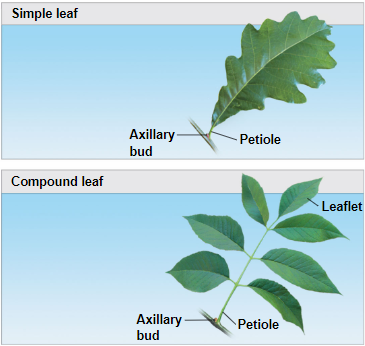 (True) Some plant species have evolved modified leaves that serve various functions.
(True) Some plant species have evolved modified leaves that serve various functions.
Dermal, Vascular, and Ground Tissues
Dermal, Vascular, Ground - Three tissue types that compose roots, stems, and leaves.
(True) - Each of the three tissue types forms a tissue system, which is continuous throughout the plant.
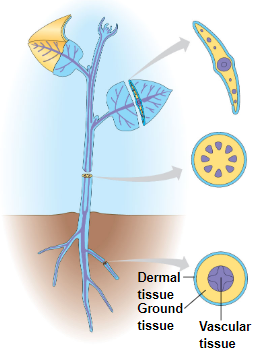 Dermal Tissue Systems
Dermal Tissue Systems
Epidermis - In nonwoody plants, the dermal tissue system consists of the?
Cuticle - A waxy coating that helps prevent water loss from the epidermis.
Periderm - In woody plants, these protective tissues replace the epidermis, especially in the older regions of the stems and roots. They are thicker and stronger than the epidermis.
Guard Cells - These are specialized epidermal cells that facilitate gas exchange in shoots.
Trichomes - Outgrowths of the shoot epidermis that can reduce water loss and reflect light. These hair-like structures can also help defend against insects.
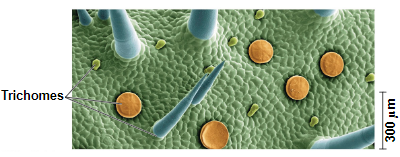 Vascular Tissue System
Vascular Tissue System
Vascular Tissue System - This system facilitates the transport of materials through the plant and provides mechanical support.
Xylem & Phloem - What are the two vascular tissues?
Xylem - Conducts water and dissolved minerals upwards from the roots to the shoots.
Phloem - Transports sugars from where they are made to storage structures or to sites of growth.
Stele - What do you call the collective vascular tissue of a root or stem?
Vascular Cylinder - In angiosperms, the stele of the root is a solid, central .
Vascular Bundles - The stele of stems and leaves is divided into _ , strands of xylem and phloem.
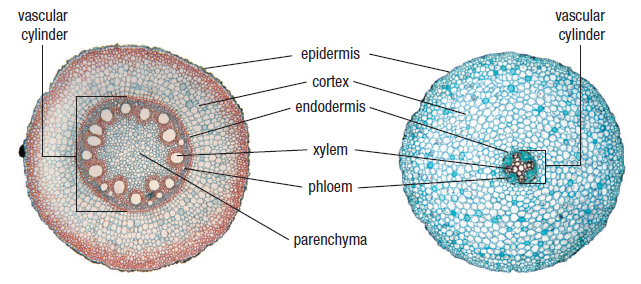 Ground Tissue System
Ground Tissue System
Ground Tissue System - All other tissues neither dermal nor vascular are part of what system?
Pith - Ground tissues internal to the vascular tissue.
Cortex - Ground tissues external to the vascular tissue.
(True) Ground tissue includes cells specialized for storage, photosynthesis, support, and transport.
Common Types of Plant Cells
Cell Differentiation & Specialization - During development, what do plant cells undergo in terms of structure and function?
Parenchyma, Collenchyma, Sclerenchyma, Water-Conducting Cells of Xylem, Sugar-Conducting Cells of Phloem - What are the major types of plant cells?
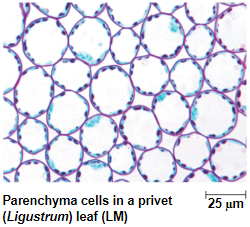 Parenchyma Cells - Have thin and flexible primary walls and they generally lack secondary walls. They also have a large central vacuole.
Parenchyma Cells - Have thin and flexible primary walls and they generally lack secondary walls. They also have a large central vacuole.
Parenchyma Cells - They perform the most metabolic functions and also have the ability to divide and differentiate.
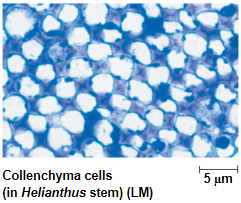 Collenchyma Cells - Grouped in strands and help support young parts of the plant shoot.
Collenchyma Cells - Grouped in strands and help support young parts of the plant shoot.
Collenchyma Cells - These cells provide flexible support without restraining growth, through their unevenly thickened primary cell walls.
(True) - Collenchyma cells are capable of living past functional maturity.
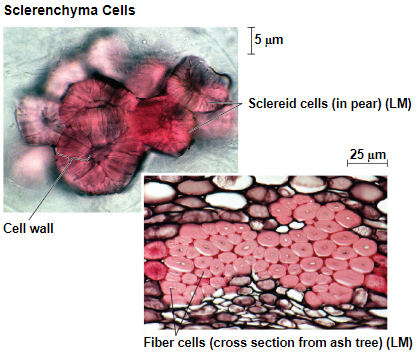 Sclerenchyma Cells - Are rigid due to thick secondary walls which contain lignin.
Sclerenchyma Cells - Are rigid due to thick secondary walls which contain lignin.
Lignin - It is a strengthening polymer found in sclerenchyma cells.
(True) Sclerenchyma cells die at functional maturity.
Sclereids & Fibers - Two types of sclerenchyma
Sclereid - Sclerenchyma cells that are short and irregular in shape and have thick, lignified secondary walls. It’s basically the standard sclerenchyma, by figure description.
Fibers - Sclerenchyma cells that are long, slender, and arranged in threads.
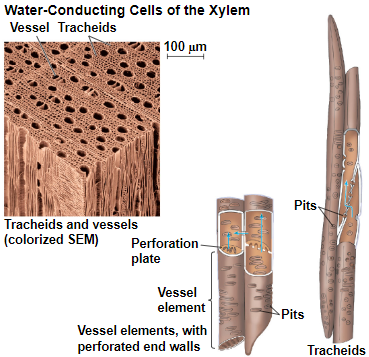 Water-Conducting Cells of Xylem
Water-Conducting Cells of Xylem
Tracheids & Vessel Elements - What are the two types of water-conducting cells in the xylem?
(True) Upon reaching functional maturity, Tracheids and Vessel elements die.
Tracheids - Are long, thin cells with tapered ends found in the xylem of all vascular plants.
Pits - Thin regions in tracheids that lack secondary cell walls. It allows for the movement water between tracheids.
(True) Vessel elements are common to most angiosperms, and a few gymnosperms and seedless vascular plants.
Vessel Elements - Water-conducting cells that align end to end to form long pipes. At the end of these pipes are plates that allow water to flow freely through them.
Vessels - Long pipes of vessel elements.
Perforation Plates - These are found at the end of vessels that allow free passage of water through the vessel elements.
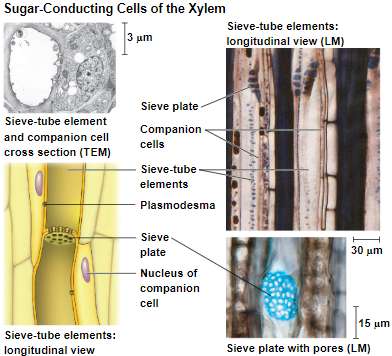 Sugar-Conducting Cells of the Phloem
Sugar-Conducting Cells of the Phloem
(True) - Cells of the phloem are alive at functional maturity, but lack organelles.
Sieve Cells - In seedless vascular plants and gymnosperms, these cells transport sugars.
Sieve-Tube Elements - In angiosperms, sugars are transported through these tubes/chains of cells.
Sieve Plates - The porous end walls between sieve-tube elements that allow fluid to flow between cells along the sieve tube.
Companion Cell - Each sieve-tube element is connected to this by a plasmodesmata.
(True) - The nucleus and ribosomes of companion cells serves both sieve-tube elements connected to it.
Concept 35.2: Different Meristems Generate New Cells for Primary and Secondary Growth
Indeterminate Growth - The ability of plants to grow throughout its life.
Meristems - These are unspecialized tissues composed of dividing cells. Their activities are the reason why plants can grow continuously.
Determinate Growth - Unlike most plants, most animals and some plants cease to grow at a certain size. This phenomenon is called?
Apical & Lateral - What are the two types of meristems?
Apical Meristems - These meristems are located at the tips of roots and shoots.
Primary Growth - This is the process wherein apical meristems elongate shoots and roots.
Lateral Meristems - These meristems add thickness to woody plants.
Secondary Growth - A process in woody plants wherein lateral meristems add thickness to its parts.
Vascular Cambium & Cork Cambium - What are the two types of Lateral Meristems?
Vascular Cambium - This lateral meristem adds layers of vascular tissues.
Secondary Xylem (Wood) & Phloem - These are the vascular tissues the vascular cambium adds during secondary growth.
Cork Cambium - Lateral meristem that replaces the epidermis with the periderm.
(True) - The epidermis is thinner and weaker than the periderm.
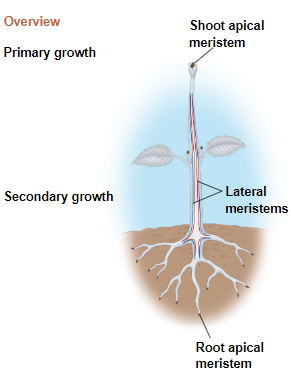
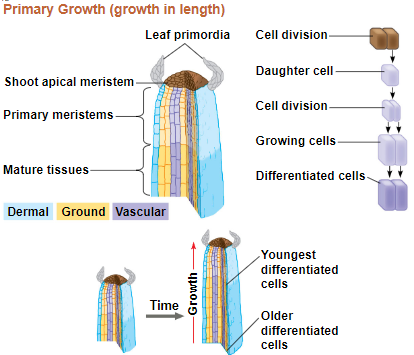
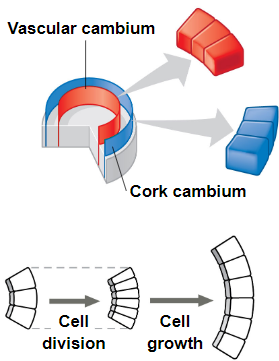
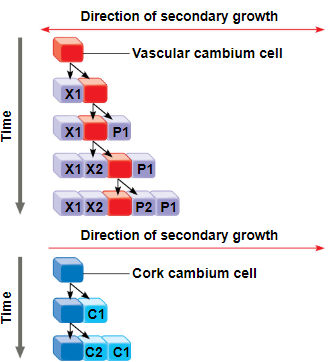
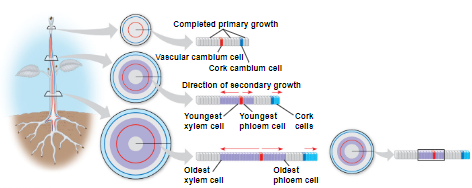 (True) - Cells in the apical and lateral meristems divide frequently during the growing season.
(True) - Cells in the apical and lateral meristems divide frequently during the growing season.
Initials - These are the new cells that remain in the meristem and produce more cells.
Stem Cells - Initials are also called?
(True) - But not all new cells get to be initials. Other new cells may be displaced form the meristem and become specialized in mature tissues.
The Three Primary Meristems
(True) - During primary growth, cells produced by the meristem give rise to three primary meristems that will produce the mature tissues of the plant.
Protoderm, Ground Meristem, Procambium - What are the three primary meristems?
Protoderm - Primary meristem that produces dermal tissue.
Ground Meristem - Primary meristem that produces ground tissue.
Procambium - Primary meristem that produces vascular tissue.
(True) - In woody plants, primary and secondary growth occur simultaneously, but in different locations.
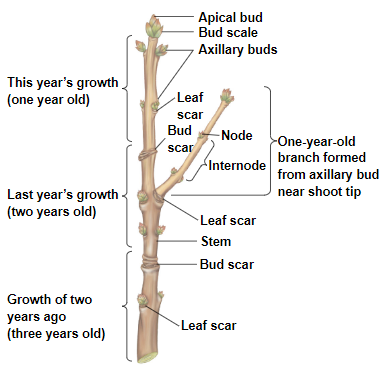 Flowering Plants
Flowering Plants
(True) - Flowering plants can be categorized based on the length of their life cycle.
Annuals, Biennials, Perennials - Three categories of flowering plants.
Annuals - Complete their life cycle in a year or less.
Biennials - Require two growing seasons.
Perennials - Live for many years.
Concept 35.3: Primary Growth Lengthens Roots and Shoots
Primary Growth - Growth that arises from cells produced by apical meristems and elongates roots and shoots.
(True) - In herbaceous plants, most of the plant consists of primary growth.
(True) - In woody plants, only new, non-woody parts experience primary growth.
Primary Growth of Roots
Root Cap - It covers the root tip and protects the root apical meristem as the root pushes through soil.
Cell Division, Elongation, Differentiation/Maturation - Growth occurs just behind the root tip, in three zones, namely:
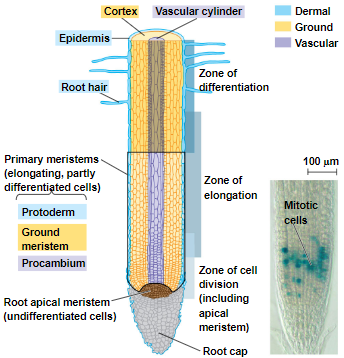 Epidermis (Dermal Tissue), Ground Tissue, Vascular Tissue - The primary growth of roots produces?
Epidermis (Dermal Tissue), Ground Tissue, Vascular Tissue - The primary growth of roots produces?
(True) - The primary growth produces the three main tissues that comprise roots, stems, and leaves.
==Protoderm ==- It is the outermost primary meristem and it gives rise to the epidermis.
70-90% - Root hairs and epidermal cells modified for absorption make up how much of the total root surface area?
(True) - The ==ground meristem== is sandwiched between the protoderm and the procambium. It gives rise to the ground tissue.
(True) - The ground tissue, mostly parenchyma cells, fills the cortex--the region between the vascular cylinder and epidermis.
Parenchyma Cells - Are plant cells that mostly comprise the ground tissue that fills the cortex.
Endodermis - The innermost layer of the cortex. It regulates passage of substances from the soil to the vascular cylinder.
==Procambium ==- The innermost primary meristem. It gives rise to the central vascular cylinder.
Pericycle - A cell layer that surrounds the solid core of the vascular cylinder.
Xylem & Phloem - What comprises the core of a vascular cylinder?
(True) - In most eudicots, the xylem is starlike in appearance, and the phloem is between its ‘arms’.
(True) - In many monocots, a core of parenchyma cells is surrounded by alternating rings of xylem and phloem.
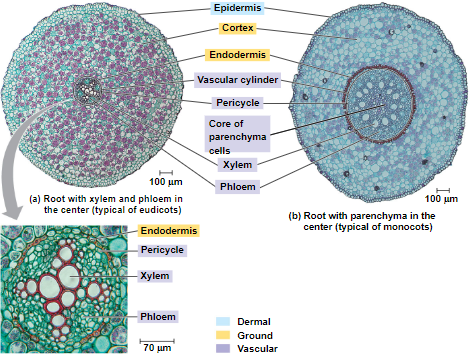 (True) - Lateral roots arise from the pericycle and destructively push through the outer tissues.
(True) - Lateral roots arise from the pericycle and destructively push through the outer tissues.
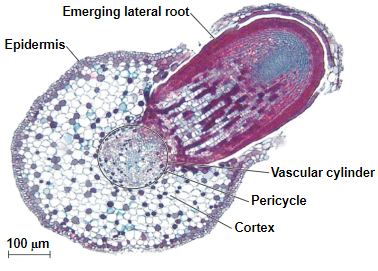 Primary Growth of Shoots
Primary Growth of Shoots
Shoot Apical Meristem - A dome-shaped mass of dividing cells at the shoot tip.
(True) - The leaves of the apical bud protect the meristem.
Axillary Buds - They develop from meristematic cells left at the bases of leaf primordia.
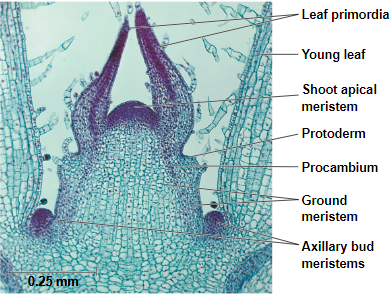 (True) - Axillary Buds are kept dormant by chemical communication from the apical bud.
(True) - Axillary Buds are kept dormant by chemical communication from the apical bud.
(True) - The closer an axillary bud is to the active apical bud, the more inhibited it is.
Apical Dominance - The power apical buds hold over axillary buds.
(False) - Axillary buds can never be released from the apical dominance.
(True) - Axillary buds are only released from the apical dominance if the shoot tip is removed or shaded.
Lateral Shoots - When the axillary buds have been released from dormancy, it creates?
Stem Growth and Anatomy
Epidermis & Waxy Cuticle - What are two things that cover the stem?
Parenchyma Cells - What are ground tissues primarily composed of?
Collenchyma & Sclerenchyma Cells - Which cells support and strengthen the stem?
(True) - Unlike roots, lateral shoots arise from axillary bud meristems on the stem surface. These do not damage stem tissues.
(True) - In most eudicots, the vascular tissue consists of vascular bundles arranged in a ring.
(True) - In most monocot stems, the vascular bundles are scattered throughout the ground tissue rather than forming a ring.
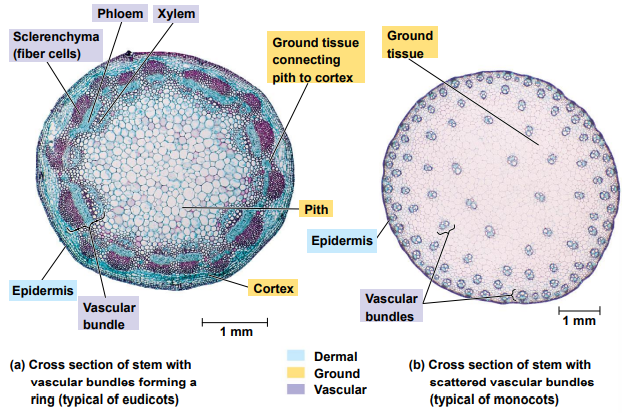
Leaf Growth and Anatomy
Leaf Primordia - Where do leaves develop from? It’s along the sides of the shoot apical meristem.
(True) - The epidermis in leaves is interrupted by stomata.
Stomata - These are pores that allow CO2 and O2 exchange between the air and the photosynthetic cells in a leaf.
(True) - Stomata are major avenues for evaporative loss of water.
(True) - Each stomatal pore is flanked by two guard cells, which regulate its opening and closing.
Mesophyll - It is the ground tissue in a leaf. It is sandwiched between the upper and lower epidermis.
Palisade, Spongy - What are the two layers of eudicot mesophylls?
Palisade Mesophyll - It is a mesophyll layer found in the upper part of the leaf.
Spongy Mesophyll - It is a mesophyll layer found in the lower part of the leaf. The loose arrangement allows for gas exchange.
(True) - The vascular tissue of each leaf is continuous with the vascular tissue of the stem.
(True) - Veins are the leaf’s vascular bundles and function as the leaf’s skeleton.
(True) - Each vein in a leaf is enclosed by a protective bundle sheath.
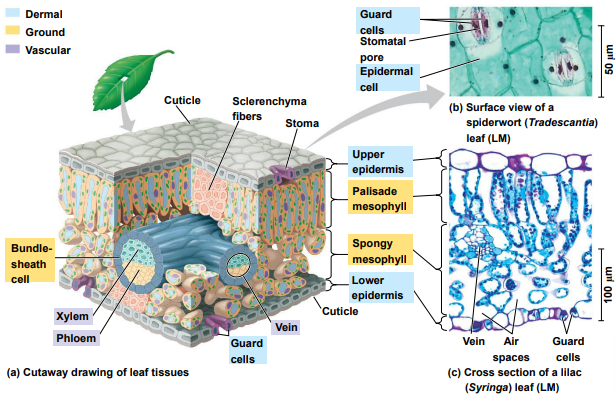
Concept 35.4: Secondary Growth Increases the Diameter of Stems and Roots in Woody Plants
(True) - Many land plants display secondary growth.
(True) - Secondary growth occurs in gymnosperms and many eudicots, but is rare in monocots.
(True) - Secondary growth occurs in stems and roots of woody plants, but rarely in leaves.
(True) - Primary and secondary growth occur simultaneously.
The Vascular Cambium and Secondary Vascular Tissue
Vascular Cambium - It is wholly responsible for the production of secondary vascular tissue.
(True) - In a typical woody stem, the vascular cambium is located outside the pith and primary xylem and to the inside of the primary phloem and cortex.
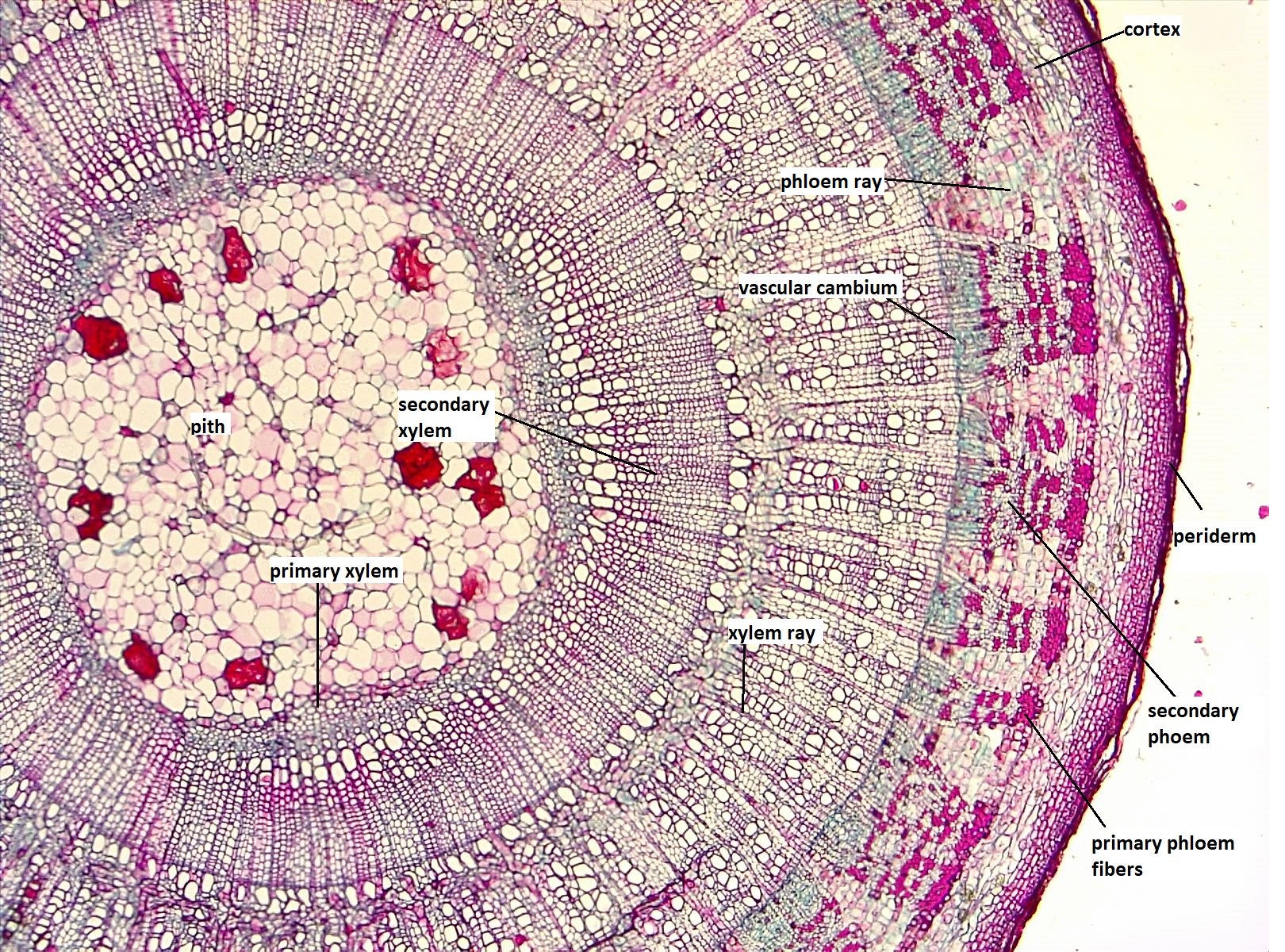
(True) - In a typical woody root, the vascular cambium forms exterior to the primary xylem and interior to the primary phloem and pericycle.
(True) - In cross section, the vascular cambium appears as a ring of meristematic cells, one cell layer thick.
(True) - Division of these cells increases the vascular cambiums’ circumference and adds secondary xylem to the inside and secondary phloem to the outside.
Elongated Initials - These are oriented parallel to the the axis of the stem or root. They give rise to tracheids, vessel elements, fibers of xylem, sieve-tube elements, companion cells, axially oriented parenchyma, and fibers of the phloem.
Shorter Initials - These are oriented perpendicular to the axis of the stem or root. They produce vascular rays, radial files of parenchyma cells that connect secondary xylem and phloem.
Secondary Xylem - The xylem that accumulates as wood and consists of tracheids, vessel elements (only in angiosperms), and fibers.
Early Wood - Wood formed in the spring in temperate regions, has thin cell walls to maximize water delivery.
Late Wood - Wood formed in the summer, has thick-walled cells and contributes more to stem support.
